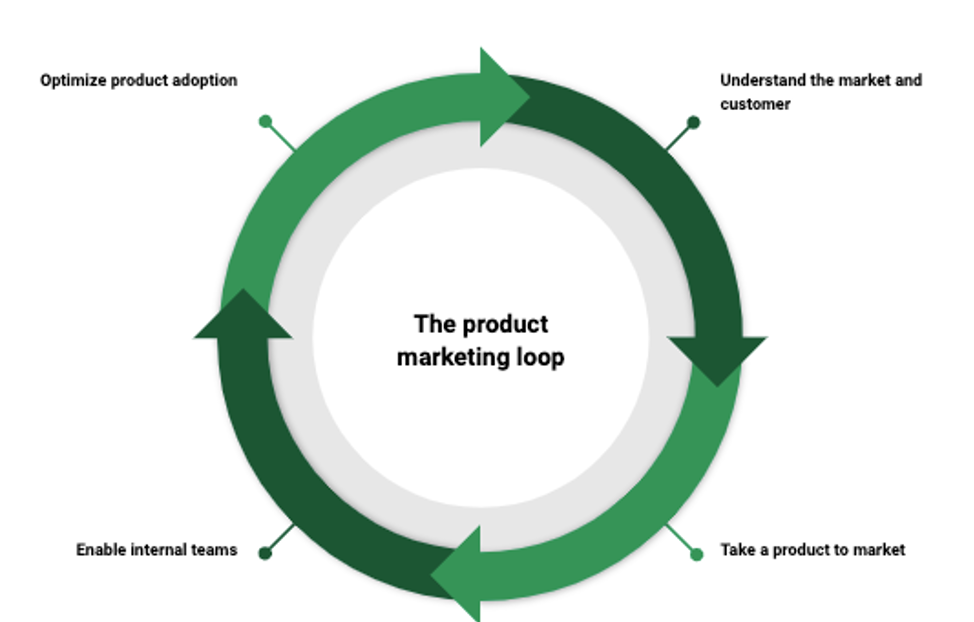The definition of product marketing is often debated. Each company and person may have a different definition, but there are typically four core components involved in successful product marketing: understanding the market and customer, taking a product to market, enabling internal teams, and improving product adoption.

These four components make for a product marketing loop in which you are continuously learning and iterating—similar to the product itself. No matter where you are in the loop, there are specific key things for you to focus in on.
Understand the market and customer
At the base of everything that a product marketer does is a solid understanding of their customer and the overall market. Decisions without this fundamental insight could lead them and their company on a dangerous, misinformed path.
The focus here is to nail down who your ideal customers are, why your product matters to them, and why they should pick your solution.
Laying the foundation
For new products, spend time with your product manager to understand the gaps and problems that customers are facing. This is your opportunity to learn why these problems matter to them. Listen to how they describe the problem, what their current situation is, why it’s on their mind, and how things would change if the problem no longer existed. When you have something to show customers, listen to how they respond and talk about the product, what they get excited about as you walk through a prototype, and how their gears start turning. Finally, as you beta test the product, validate your messaging. Did everything you learned from your prior customer engagements actually resonate? How are beta customers reacting to the product? How have things changed for them since using the new product?
For existing products that are already in the market, things are not much different. Engage with customers and learn. Sit in on sales and onboarding calls to listen to the questions and topics that come up (you can also record calls for on-demand listening). Set up customer interviews to learn how your customer is using the product or to build out case studies and testimonials. Use this time to listen for benefits you may not have thought about previously. Listen for patterns.
There are so many ways to learn about your customers, from actually having conversations with them to running surveys or just sifting through data and comments online. Find ways to learn a little bit more about your customers each day, as this is a pivotal building block to success in any product marketing role.
Differentiating your why
More than likely, you are not the only company offering a solution to your customer’s problem. So, although you have defined who your ideal customer is and why what you offer matters to them, you still need to clearly articulate why they should go with you to help solve their problem.
This is where market and competitor analysis comes in. In order to separate your product from the handful of others that your customers may be evaluating, you need to understand what those other options are. Use your Sales team to collect knowledge on who, or what, prospects are transitioning from, as well as who else they are considering. Spend some time reviewing competitor websites and assets to see how they talk about their product, what features they highlight, how they price their product, and the type of customer they’re targeting. Read reviews to see what customers think about your competitors, both positive and negative.
Take this information, along with your understanding of why customers care about the problem you’re solving, and use it to position and differentiate yourself against your competitors. This does not necessarily have to be a product or feature differentiation, which is harder to come by in the world of software. It could be your level of support, your thought leadership around a certain topic, or even specialization in segments that your competitors do not serve as well.
Take your product to market
As you launch your product to the market, you, as the product marketer, are the quarterback. You play a central role in enabling your colleagues, which we will touch on later, and helping to drive business objectives during and post-launch.
With a good grasp of your positioning and messaging, the final steps to taking a product to market are creating alignment around launch KPIs and coordinating a marketing strategy on how and where you will engage with potential customers.
Work with your marketing and demand gen team to determine the best channels to reach your audience. Build out content to drive awareness and education, whether that be blog posts, ebooks, whitepapers, or webinars. Determine at which events you want to promote your product and how it will be showcased. Make sure your customer experience team has what they need to build out support material, and that the full customer journey has been considered.
The product marketer may not be responsible for delivering every item involved with the launch, but they are the enablers of success.
Enable internal teams
You typically hear about sales enablement but you actually need to enable all internal teams, from marketing to customer experience (CX).
An ideal way to do this is through a go-to-market strategy document. This is a single source of truth that outlines your target segments and personas, the problem you’re solving, your positioning and messaging framework, the competitive landscape, all finalized pricing and promotions, as well as planned marketing activities.
Using this document, and the information from it, product marketers can enable the necessary teams needed for a successful launch. Make sure Marketing knows who they need to be targeting and the messaging that will drive action, that CX knows the problem the product is solving for so they can build support content with that in mind, and that Sales understand the right customer for the product and the key messages and narrative that will resonate.
As your product continues to grow and change, it is important to make sure you share relevant updates with all teams through continuous enablement.
Finally, traditional sales enablement does mean making sure that your sales team is armed with the tools and assets needed to successfully nurture prospects through the funnel and close deals. This means making sure the team has sales decks, one-pagers, case studies, pricing sheets, ROI calculators, etc.
Optimize product adoption
Typically, product marketers focus on those first three components and then end right there. But product adoption is such an important part of what we as product marketers do. We do not build products for people to just buy it, we build products for people to use and get value from it. So why do we as product marketers typically stop worrying about our customers once we’ve acquired them?
It is time for product marketers to play a larger role in helping drive adoption and usage. Tinker with and find the right channels and messaging that unlock usage for your key features: the ones that will delight customers and keep them coming back. Look for common characteristics among your most active and valuable customers. Take that knowledge and circle back to where you began, understanding the customer. Why is this specific segment of customers using your product more? Is there something interesting about the type of customer? Maybe it is a specific size customer or those from similar industries.
Use your learnings to optimize for product and feature adoption—positioning for usage rather than for sales.
So now what?
Many of you have an existing product in the market, so start by evaluating your adoption and usage numbers. Are the customers that are buying your solution actually using it and finding value? Use product data and customer conversations to find the answers you are looking for. Again, this is a loop so you can truly start from anywhere. Maybe you already know that you have an adoption issue, in which case start better understanding the customers who are using your product. Why did they buy your product? How have things changed for them? Are you noticing any patterns?
For those of you who are gearing up to launch a new product or feature, make sure you have done the research and analysis to truly understand why and how your product is going to deliver value for your target audience. Use that insight to build towards a successful launch.
Work your way through the loop and then, start all over again!


















 Follow us on LinkedIn
Follow us on LinkedIn




.svg)
Start the conversation
Become a member of Product Marketing Alliance to start commenting.
Sign up now